By Didier FRANC
The new context API that comes with React 16.3 is pretty neat. It was built in the render props style trending over these last months. Let’s explore it:
It’s pretty nice right? Let’s go further with Flux-like implementation.
What’s Flux ?
This talk from the excellent Jing Chen has revolutionized how we think about our applications today. If you want to know what Flux is as a concept, take a look here.
 A basic Flux representation
A basic Flux representation
One library has democratized this concept: Dan Abramov’s Redux and its legendary time travel demo at React Europe 2015.
Implementation
With the createContext() API example above, we already have the unidirectional Store → View in place.

What we need is actions and dispatchers to dynamically update the store. What if our dynamic store was just the state of a root React component?
We have just passed state and actions as values of the provider. And now we can get it with <Consumer />.
I created a library to have everything we need to use this data flow easily while keeping great performance.
react-waterfall
 _Example repository available [here](https://github.com/didierfranc/react-stateful-example" rel="noopener" target="blank" title=")
_Example repository available [here](https://github.com/didierfranc/react-stateful-example" rel="noopener" target="blank" title=")
Just import initStore from react-waterfall, set your initial state, and take some actions: (state, …arg) → stateChunk — and you’re good to go.
The created store gives you some cool things like:
- The enhanced Provider and Consumer presented above
- actions (you can access them from Consumer, too)
- getState() to get the current state
- connect()() to map state and actions to component props
- subscribe() to react to state changes
If you need deeper selectors and/or memoized computed data, you can, of course, use reselect. Check out this example here.
If you want time travel, it’s possible ? to just run this example. The implementation is right here.
Comparison with Redux

ℹ️ Redux Devtools have been integrated by default in the version 4.0.0, you’ve nothing to do, it just works.
Pros
- Easier to implement
- Weight and performance
- Cleaner action return with state chunk (as in setState)
Cons
- It only works with React ^16.3
You want to try it ?
I̶ ̶h̶a̶v̶e̶ ̶n̶o̶t̶ ̶f̶o̶u̶n̶d̶ ̶a̶ ̶s̶e̶x̶y̶ ̶n̶a̶m̶e̶ ̶f̶o̶r̶ ̶i̶t̶ ̶y̶e̶t̶,̶ ̶b̶u̶t̶ ̶i̶f̶ ̶y̶o̶u̶ ̶h̶a̶v̶e̶ ̶a̶n̶ ̶i̶d̶e̶a̶ ̶f̶o̶r̶ ̶i̶t̶ ̶p̶o̶s̶t̶ ̶y̶o̶u̶r̶ ̶s̶u̶g̶g̶e̶s̶t̶i̶o̶n̶s̶ ̶h̶e̶r̶e̶ ̶o̶r̶ ̶s̶e̶n̶d̶ ̶m̶e̶ ̶a̶ ̶t̶w̶e̶e̶t̶.̶ ̶F̶o̶r̶ ̶n̶o̶w̶ ̶i̶t̶’̶s̶ ̶o̶n̶l̶y̶ ̶a̶v̶a̶i̶l̶a̶b̶l̶e̶ ̶v̶i̶a̶ ̶G̶i̶t̶h̶u̶b̶.̶
yarn add react-waterfall
?
More
If you’re interested by new React key features don’t miss “When react has become (even more) asynchronous”.
If you don’t want to miss any of my articles, follow me on twitter @DidierFranc
